Black Widow Anemone: Appearance, Care, Pricing & More
Posted by on 01/31/2023
Fact checked by
We use affiliate links and may receive a small commission on purchases.
The Bubble Tip Anemone, often abbreviated as BTA, is a favorite among hobbyists for a reason. These anemones add movement to an aquarium with their swaying tentacles and play host to a variety of different types of anemonefish species.
While there are numerous bubble tip anemone color morphs, one of the most sought-after is the Black Widow Anemone. This sea anemone has a striking appearance, and its rarity comes with a high price tag. In this post, we're going to cover everything you'll need to know if you plan on adding one of these invertebrates to your reef tank.
Species Summary
The Black Widow Anemone (scientific name: Entacmaea quadricolor) is an eye-catching Bubble Tip Anemone color morph. Its color, determined by the zooxanthellae that live in its tissue, makes it quite an interesting specimen.
Bubble Tip Anemones are widespread throughout the Indo-Pacific, where they have a mutualistic relationship with Clownfish. These invertebrates feed using their tentacles, and their "bubble tip" appearance is based on the lighting and flow rates to which they are exposed.
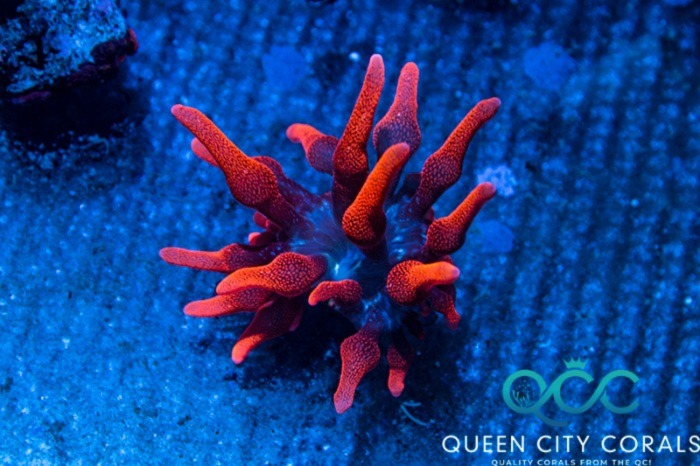
Size
Black Widow Anemones can grow to be quite large, a well-cared-for specimen can grow to be over 12 inches in diameter. Most hobbyists will purchase much smaller anemones, typically between 1-2 inches in size.
As with all invertebrates, providing pristine water conditions and a nutrient-rich diet will allow your anemone to reach a healthy size.
Growth Rate
In an ideal environment a Black Widow Anemone can double in size over six months.
Black Widow Anemones, similar to other Bubble Tip Anemone color morphs, are fast-growing Healthy anemones will either grow or split. While splitting can be a sign of stress, it can also occur in healthy corals.
Appearance
The Black Widow Anemone is recognizable by its striking combination of bright pink and red tentacles and a blue and black oral disk.
Healthy black widow anemones should have inflated tentacles and bright colors. They should not display any abnormal swelling near their mouths.
The tips of their tentacles should be rounded, giving off the "bubble" appearance seen in the Entacmaea species.
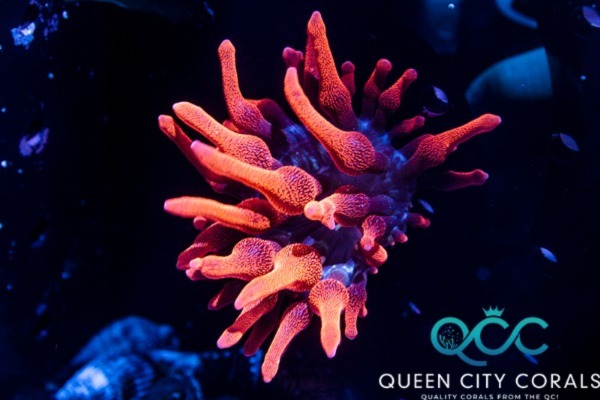
Black Widow Anemone vs Rose Bubble Tip Anemone
At first glance, it's easy to mistake a Black Widow Anemone for a Rose Bubble Tip Anemone. Rose Bubble Tip Anemones are slightly more common when compared to the Black Widow, but are still quite rare. You'll need to closely examine the base of the anemone to spot the difference between these two morphs.
Rose Bubble Tip Anemones have a vibrant, neon blue color that fades into the rose coloration seen on the tips of the anemone's tentacles. Rose Bubble Tips also tend to be a lighter shade of pink compared to the deeper reds seen in the Black Widow color morph.
If the base of the anemone is dark blue and black, it's a black widow.
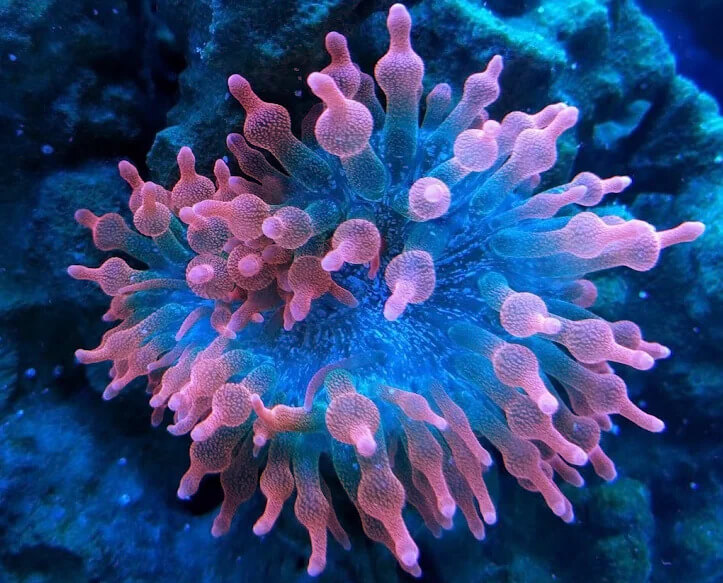
Black Widow Anemone Care
If you're deciding on a black widow anemone, be warned - anemones are not the easiest species to keep in a reef aquarium.
They grow much faster compared to slower-growing corals, such as Blastomussa and Chalices, and you'll want to be sure that you have all of the knowledge needed to ensure their success.
Tank Size
We recommend a mature aquarium that's at least 100 gallons in size for a Black Widow Anemone. Since these anemones are fast-growing, having a larger tank should give you plenty of room to account for their growth rate.
While technically any established reef tank will do, larger tanks tend to be more stable and will give you more room when placing other corals so that you don't encounter any territorial issues.
Water Parameters
The Black Widow Anemone shares the same water parameter requirements as any other Bubble Tip Anemone color morph.
Keep in mind, stability is the most important aspect when keeping any coral or invertebrates, and the same is true for the Black Widow Anemone.
You'll want to aim for the following:
Water Temperature: 77°F - 80°F
pH: 8.1 to 8.4
Water Hardness: 8 to 12 dKH
Specific Gravity: 1.024 to 1.025
Nitrate: < .5 ppm
Phosphate : < .04 -.06 ppm
Maintain these conditions for as long as you plan on housing a Black Widow Anemone.
Tank Setup
You'll want to make sure that your aquarium is mature (2-6 months) before adding a Black Widow Anemone. If you're starting a new tank, it's beneficial to carefully plan out your aquascape ahead of time so that you can account for the addition of new coral and livestock.
Keeping a Black Widow Anemone, or any anemone for that matter, is no easy feat, and having a properly set up aquarium will make your life much easier.
Placement
The Black Widow Anemone, similar to other Anemones, will move around your aquarium until it decides on a more permanent location.
Anemones move around the tank via their Basal or Pedal disc, often referred to as their foot. This movement can be problematic if you're adding an anemone to an established aquarium. When an anemone decides on a location that it likes, it may sting and attack any neighboring corals.
Even though bubble tip anemones have weaker stings compared to other types of anemones, you'll want to make sure that your other corals aren't at risk of being stung.
We recommend adding an anemone to your tank before adding additional coral. You'll want to monitor your Black Widow Anemone until it decides on a location that it likes. Keep your powerheads turned off during this period so that the anemone doesn't risk injury from the powerhead blades. ou'll want to make sure that your other corals aren't at risk of being stung.
Lighting
Aim for at least 200 PAR at the bottom of your tank if you plan on keeping a Black Widow Anemone.
When hobbyists experience issues with anemones, the number one culprit is often lighting. If the lighting is too weak, anemones expel their zooxanthellae, resulting in bleaching.
Both blue and white lighting can be used, keeping in mind that blue lighting will penetrate the water much deeper when compared to white lighting.
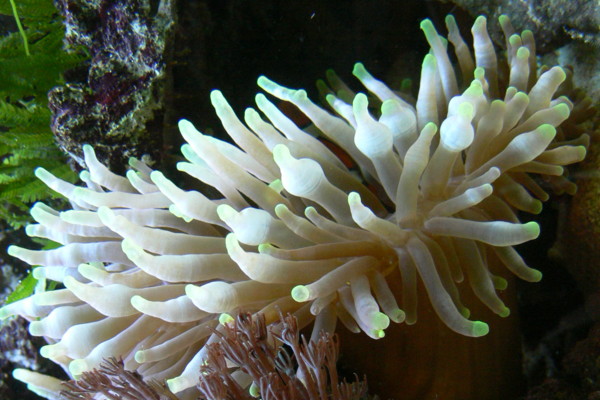
Flow
We recommend a moderate amount of flow for the Black Widow Anemone. Bubble Tip Anemones often have individual preferences when it comes to flow. Having a moderate amount of flow will allow your Black Widow to decide on a spot in the tank where they feel the most comfortable.
Too much flow and your anemone may appear stretched out. An adjustable powerhead can be used to dial in the appropriate flow rate.
Feeding
The Black Widow Anemone is a photosynthetic species. Due to their symbiotic relationship with zooxanthellae, their primary food source comes from light, but they will also use their tentacles to consume food from any hosted fish. Although optional, you can also supplement your anemone's diet with direct feeding.
Using a pair of tweezers, you can feed your anemone small bits of Mysis, Brine, and thawed scallops. Direct feeding at least twice a week will result in faster growth rates and healthier anemones.
Behavior
One of the most known behaviors of sea anemones is their ability to host different types of anemonefish.
Black Widow Anemones are capable of hosting anemonefish, but keep in mind that Captive-bred fish tend to host less frequently compared to wild-caught species, and the pairing is often the result of individual preferences between both the anemonefish and the anemone. Just because an anemonefish doesn't host your anemone, doesn't mean there is an issue with your tank.
In terms of movement, anemones are slow-moving invertebrates, and once settled they rarely change positions. However, their tentacles will sway with the flow produced by powerheads in the tank, adding a lot of motion to the water column.
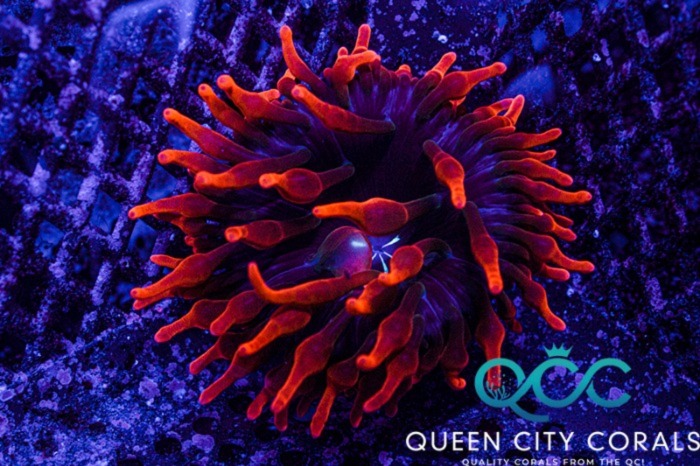
Fragging
Black Widow Anemones will naturally split when under stress. Some hobbyists will intentionally induce stress by modifying their water parameters in hopes that their anemones will split. There are risks to doing this, as a stressed coral may never fully recover.
Using a sharp pair of scissors or a razor blade, you can also slice directly through the mouth of the anemone. It's important to not damage the foot of the anemone, so use caution. After you've cut through the anemone, you can place both halves back into your display tank.
As you can see, there are risks with trying to frag a Black Widow Anemone. Unless you're experienced and fully aware of the risks, we recommend allowing the Black Widow Anemone to split naturally. If it's meant to be, it's meant to be!
Pricing
Black Widow Anemones are a rare and expensive color morph. These invertebrates are wild-caught and are often traded after they've split.
Their rarity correlates to a high price tag. Hobbyists can expect to pay up to $300 for just a 1-2" Black Widow Anemone.
Tank Mates
If you're building an aquarium around a Black Widow Anemone, you can add other corals such as torches, brain corals, leather corals, and chalices, but you'll want to make sure that your anemone has established itself so that it won't move around the tank and sting other corals.
Having a mixed reef tank with anemones and corals should only be tackled by an experienced hobbyist. Always allow for plenty of space between any corals you plan on adding.
Reefers looking for a challenge can also add other types of anemones, but you'll need a large enough tank (130 gallons+). Just be sure to keep an eye on your anemones so that they don't get too close and attack each other with their stinging tentacles.
As far as livestock goes, any reef-safe fish will do, some of our favorites include:
- Pink Skunk Clownfish
- Blonde Naso Tang (you'll need at least 180-gallon tank for this species)
- Cleaner Shrimp
- Snowflake Clownfish
- Blue Chromis
- Orange Spotted Goby
- Pink-Streaked Wrasse
Avoid Butterflyfish, Angelfish, and Puffers, as they will pick at your anemones. Eels, such as the Tessalata should also be avoided, as they can easily knock around coral and invertebrates.
Conclusion
That just about covers everything when it comes to Black Widow Anemones. Now that we've touched on all the topics, do you plan on adding one to your collection? There are plenty of things you need to consider before making such an expensive purchase, but for many, owning a Black Widow Anemone is well worth the investment.
Let us know if you have experience or plan on purchasing one of these unique anemones. Don't forget to check out our marketplace where hobbyists trade corals, and visit our community forum where we discuss everything related to both freshwater and saltwater aquariums.
December's Giveaways on Light Fish








